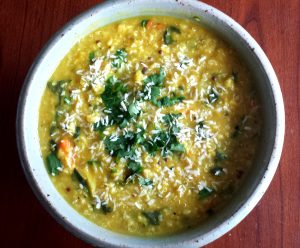 Although kitchari is not a necessity to have an Ayurvedic diet, it can definitely be a healthy staple for those that choose. In fact, more days than not, I find myself making (and craving) this dish on a daily basis. The reason why I LOVE this dish so, is because of the versatility in taste, ingredients, and health properties that it possesses. Kitchari can vary quite a bit in quality depending on the spices, oils, veggies, dal, and grain used. Some kitchari recipes may be perfect for a cleanse, while others may be more useful in rejuvenation therapy. Some may be beneficial for the fall season and others better for summer. This tridoshic Kitchari recipe, is considered very sattvic (balanced) by nature, and therefore useful for all times!
Although kitchari is not a necessity to have an Ayurvedic diet, it can definitely be a healthy staple for those that choose. In fact, more days than not, I find myself making (and craving) this dish on a daily basis. The reason why I LOVE this dish so, is because of the versatility in taste, ingredients, and health properties that it possesses. Kitchari can vary quite a bit in quality depending on the spices, oils, veggies, dal, and grain used. Some kitchari recipes may be perfect for a cleanse, while others may be more useful in rejuvenation therapy. Some may be beneficial for the fall season and others better for summer. This tridoshic Kitchari recipe, is considered very sattvic (balanced) by nature, and therefore useful for all times!
There are countless kitchari recipes available. This particular kitchari recipe is made using quinoa, rather than the traditional basmati rice. Although I love basmati rice, it is still a refined grain that possess heavy and sticky qualities, while lacking in fiber and other vital nutrients. In fact, many individuals (especially with high Kapha) report feeling very heavy, sleepy, and bloated after eating white rice. Alternatively, quinoa is light in quality and is a complete protein source with a wide range of vitamins and minerals.
A few other factors that really make this kitchari recipe amazing are the colorful veggies that provide a cleansing, alkalizing, and nutritive effect, and the gently warming digestive spices that can be used by all dosha types. With all of these aspects in mind, it is no wonder why this recipe can be used long-term, no matter the season or your personal body-type.
Tridoshic Mung Dal and Quinoa Kitchari Recipe
Click here for a printable copy of this recipe.
- Doshic effect: Vata↓, Pitta↓, Kapha↓
- Serves: 4 to 6
- Time: 15 minutes
- Cook time: 30 minutes
- Gluten Free, Vegetarian (can be made vegan)
Materials
- Cutting board and knife
- Large soup pan
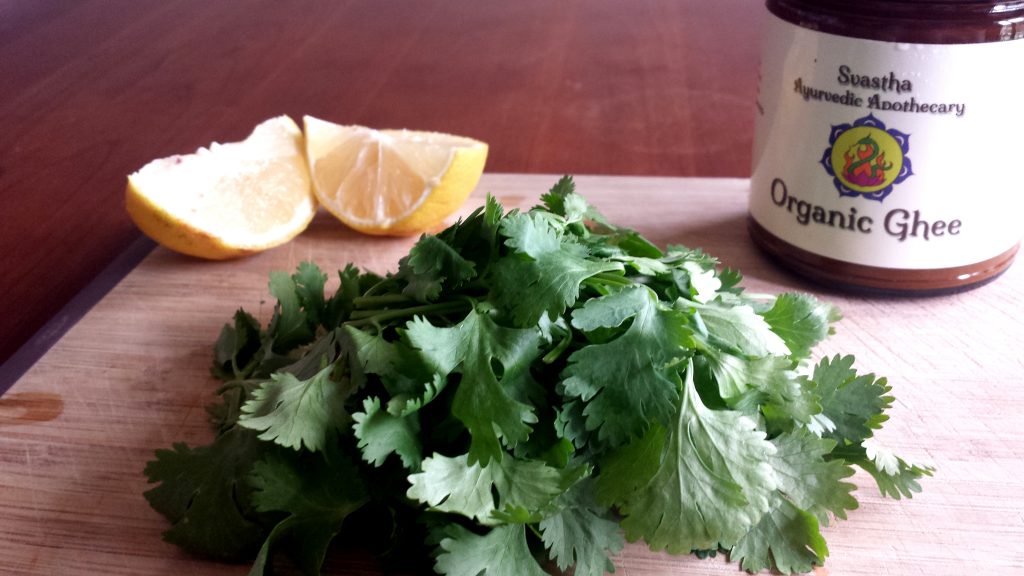
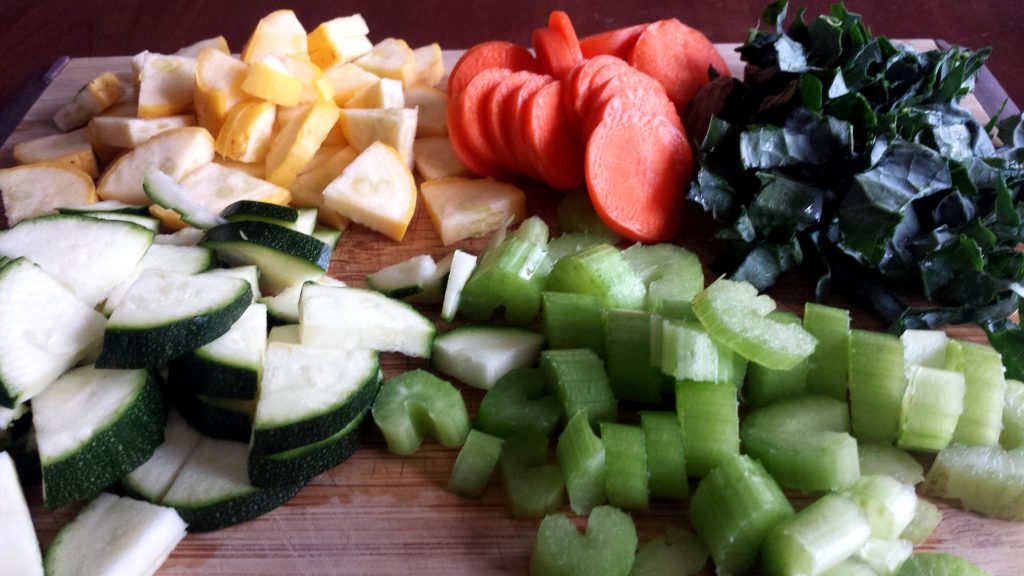
Ingredients
- 1 tablespoon sesame oil (use coconut oil for Pitta)
- 1/2 teaspoon cumin seed, whole
- 1/4 teaspoon freshly ground black pepper
- 1/2 teaspoon turmeric powder
- 1 teaspoon Tridoshic Spice Blend*
- 1 tablespoon finely grated ginger
- 1 tablespoon shredded coconut (omit for Kapha)
- 6 1/2 cups water
- 1 cup mung dal
- 1 cup quinoa
- 1/2 medium zucchini, chopped
- 1/2 medium yellow squash, chopped
- 1 celery stalk, thinly sliced
- 1 medium carrot, thinly sliced
- 1 cup chopped baby spinach leafs (use kale for Pitta)
- 1/2 teaspoon pink Himalayan salt
- 1 lime, juiced
- Chopped cilantro leaves, for garnish
- Chopped green onion, for garnish
- Shredded coconut, for garnish (omit for Kapha)
- Ghee, for individual servings (optional)
*Substitute with 1/4 teaspoon each of turmeric, ginger, cumin, coriander, and fennel powder.
Click here for a printable copy of this recipe.
Directions
1. Place a large soup pan over medium heat and add the sesame oil. Once the oil is warm, add in the cumin and black pepper. Stir continuously for 2 minutes.
2. Add in the turmeric, Tridoshic Spices, fresh ginger, and shredded coconut. Stir for an additional 30 seconds.
3. Add in the water and bring it to a boil over high heat.
4. Turn down the heat to medium and add in the mung dal. Cook here for 15 minutes, stirring every 5 minutes. The pot should be covered, but slightly cracked to avoid the water from overflowing.
5. While this is cooking begin to chop the zucchini and yellow squash. Cut the celery and carrot into thin slices.
6. After 15 minutes, add in the quinoa, celery, zucchini, yellow squash, and carrot. Cook on medium heat for 10 minutes, stirring every 3 to 4 minutes to avoid the food from sticking to the bottom of the pan. If the kitchari becomes too thick, carefully add more water by the quarter cup.
7. While waiting, chop the spinach.
8. After 10 minutes, add in the spinach, reduce the heat to low, cover the pan completely, and cook for 5 minutes. Stir every 1 to 2 minutes to avoid the kitchari from sticking to the bottom of the pan.
9. After 5 minutes, check on the dal to make sure it is soft, mushy, and well cooked. The veggies should be soft as well, but still vibrant in color.
10. Once you have your desired consistency, turn off the heat. Add in the salt and lime juice. Blend all of the ingredients evenly. Cover the pan and let it sit for a 3 to 5 minutes to allow the flavors to come together.
11. Once you have served the kitchari in bowls, sprinkle each bowl with cilantro, green onion, and shredded coconut. Add in 1 teaspoon of ghee (if used) per serving. Extra salt and pepper can be added at this time as well.
12. Eat, share, enjoy, and nourish.
Ingredient tip: If this recipe becomes a regular staple for you and your family, feel free to get creative by substituting different vegetables such as sweet potato and beets in the winter and fall, and asparagus, broccoli, and cauliflower in the spring and summer.
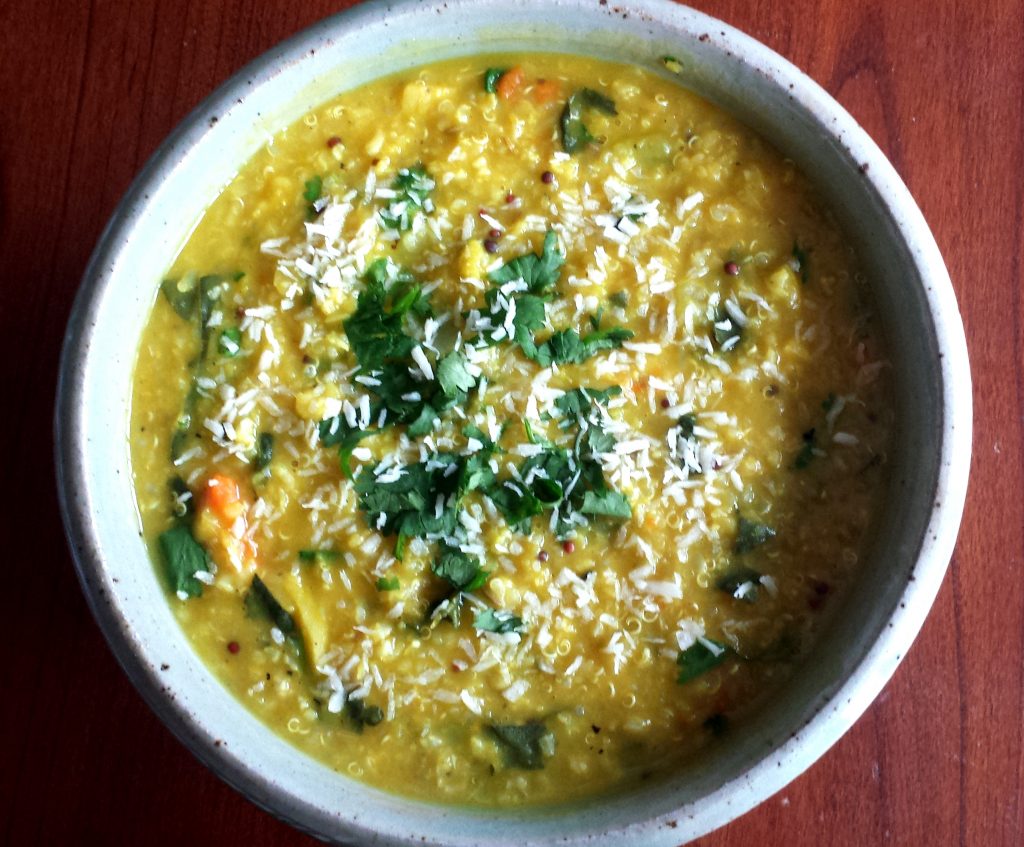
Discover more healing recipes with my 30-Minute Ayurvedic Cookbook!

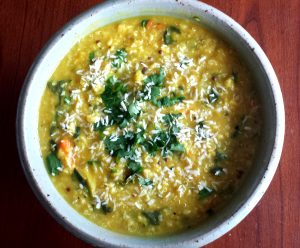
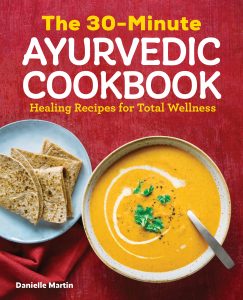

Amazing!!
Thanks Paola! I am so glad you enjoyed this healing recipe.
Namaste,
Danielle
How can I know my Dosha?
Hi Carmen,
The best way to really assess your dosha is to have a consultation with a knowledgeable Ayurvedic practitioner, either in person (best!) or even a remote session by phone or video conference. In the mean time, you can take an online quiz such as our Discover your Dosha Quiz. This is not always 100% accurate, but at least it can give you a general idea of where to begin until you find a practitioner and receive a detailed assessment. Please let me know if you have any further questions!
Namaste,
Danielle
Thanks so much for sharing this recipe, it looks delicious!
Thank you for taking the time to write in Avalon! I hope you enjoy this nourishing meal:)
Namaste,
Danielle
Hi Danielle I’m making the tridosha khichdi today and prepping it for the next few days too. I have severe constipation and cleaning out my stomach is a big problem in my life. Weight gain and obesity associated with it also. I’m going to try eAting khichdi to give my kapha dosha some help. Wish me luck
Hi Jotika,
I think this recipe will be a great addition to help balance your issues with both constipation and Kapha. Eating warm, mushy foods such as this will be easier on the digestion which will benefit the weight gain (which often is associated with a sluggish digestion) as well as aid in healthy elimination. I just posted a new article that goes over some more remedies for constipation. You can read about them here. You can also read about an Ayurvedic plan for weight loss here.
I wish you the best on your journey toward health and balance. Please feel free to contact me anytime questions arise! I hope you enjoyed the recipe:)
Namaste,
Danielle
Thank you, Danielle, for the wonderful recipe.
One question: is Garam masala an okay substitute for Agni Churna?
Hi Glen,
Thank you for your question! In terms of flavor, the Garam Masala will taste great with this recipe. The only thing to look out for will be the heating effect that may arise from the Garam, due to the chile pepper that is often an ingredient in this particular spice blend. Therefore if you are a Pitta type or have a Pitta imbalance, you may need to reduce the amount of spice added to avoid increasing Pitta further. If you are a Kapha or Vata type however, this should not be an issue.
I hope you enjoy!
Namaste,
Danielle
Thank you, Danielle.